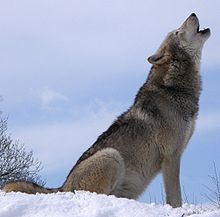
Howling is a vocal form of animal communication seen in most canines, particularly wolves, coyotes, foxes, and dogs, as well as cats and some species of monkeys.[1][2] Howls are lengthy sustained sounds, loud and audible over long distances, often with some variation in pitch over the length of the sound. Howling is generally used by animals that engage in this behavior to signal their positions to one another, to call the pack to assemble, or to note their territory.[3] The behavior is occasionally copied by humans, and has been noted to have varying degrees of significance in human culture.[4][5]
- ^ Faragó, Tamás; Townsend, Simon; Range, Friederike (2014). "The Information Content of Wolf (and Dog) Social Communication". Biocommunication of Animals. Fig. 4. doi:10.1007/978-94-007-7414-8_4. ISBN 978-94-007-7413-1 – via Researchgate.
- ^ Colley, Bill (29 April 2022). "Hunting is Altering the Evolution of Yellowstone Wolves". News Radio 1310 AM and 96.1 FM. Retrieved 2023-02-18.
- ^ National Research Council (US) Institute for Laboratory Animal Research (1996). Read "Guide for the Care and Use of Laboratory Animals" at NAP.edu. doi:10.17226/5140. ISBN 978-0-309-05377-8. PMID 25121211.
- ^ "Why people in the US have started howling at night during the coronavirus pandemic". The Indian Express. 2020-04-10. Retrieved 2023-02-18.
- ^ "Why do we howl? An expert explains". www.9news.com. April 25, 2020. Retrieved 2023-02-18.